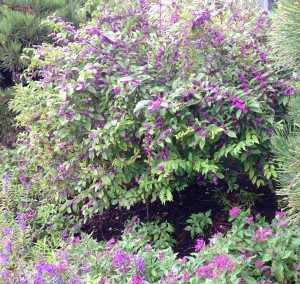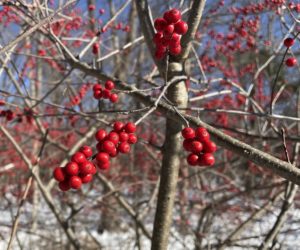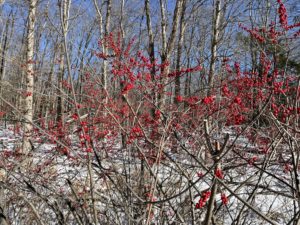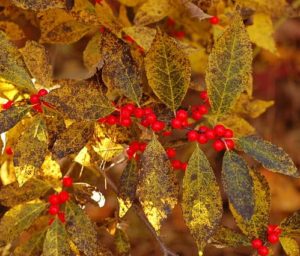Hello, fellow lovers of all things green,
One of my joys is meeting and working with others who relish our dear earth’s gifts, often leading to sharing life stories. There’s something about being in a garden and amongst nature that releases the tension of day-to-day living, inviting us to speak heart to heart.
Then there’s rubbing shoulders with fellow gardeners, many far more accomplished than I am in nurturing plants. Such is the case of Jacquie of Byram, NJ. We worked together to create a landscape of her dreams with various colors, primarily purples, pinks, and yellows, adding to the lovely plants she already had. (You’ll enjoy the story, She’s a Beautyberry, with before and after photos of her garden and bits of life stories we shared.)
Why Beautyberry is a Favored Plant
“This is my newest favorite plant,” Jacquie said, pointing to a Beautyberry (Callicarpa dichotoma) with its light green foliage and branches lined with soon-to-ripen tiny lavender-pink berries. It’s one of my favs, too and deer stay clear.

Beautyberry (Callicarpa dichotoma) in October

Beautyberry (Callicarpa Americana)
It berries best in full sun, though it can take part shade in zones 5 through 8. She may die back in rough winters here, but not to worry. She blooms on new wood. They love to be in groups to cross-pollinate, which augments the iridescent berries that coat their branches, reaching their full glory by October. The berries persist after the leaf drop and are a source of food for feathered friends.
While Callicarpa dichotoma is native to eastern Asia, C. Americana is native to the southeast and grows a bit larger to six feet tall and wide. The native Beautyberry is said to repel mosquitoes, and the berries can be made into jelly or wine. What a beautiful thing.
Beautyberries have faded now, but there’s another native plant in its glory –Winterberry, with the recent snow adding to the radiance.
About Adaptable Winterberry
Ilex verticillata is deciduous, giving the berries center stage after losing their leaves. Native all along the east coast and west to Missouri, it grows in low-lying, moist woods, though you’ll find it on higher, drier grounds, too.
Also called Black Elder, Winterberry is an adaptable plant hardy in zones 3 through 9. They thrive in full sun to part shade and moist soil with a pH of 4.5-6.5. And while they’ll sucker, especially in wet conditions, they aren’t invasive, making them ideal for rain gardens. Or as a swath along a woodland edge.
Winterberry’s Importance to Wildlife

Winterberry Berries
Birds love the berries once they soften, which is why they remain on the branches well into the winter before our feathered friends have their feast. And while deer may eat the berries, along with squirrels, raccoons, mice, and rabbits, the plant is rated Seldom Severely Damaged by Rutgers University’s Deer Resistant list.
I should note that Winterberry is toxic to humans, dogs, cats, and horses, but only mildly so. But given its importance to wildlife over winter, planting where pets won’t indulge is prudent.
The straight species, Ilex verticillata, grows 6 to 10 feet tall and wide, sometimes 15 feet. But there are several cultivars (listed below) to consider depending on the size plant and the color of the berries you desire.
Check for the suggested pollinator for the Winterberry of choice as you shop. Typically, you’ll need one male plant within fifty feet. The key is to be sure the male and female plants flower simultaneously— some flower early and others flower late.

Winterberry (Ilex verticillata)
There’s a Legend of Winterberry
I found a tune from a long-ago children’s show, Bear in the Big Blue House. The Legend of Winterberry song tells of a hungry bear coming upon one lone berry. Then he sees another bear meandering by.
The lyric— “Come one, come all, come short and tall, sing hi-dee-ho-dee-dairy. And what would you do if it were you with just one Winterberry?”
The hungry bear chooses to share the tiny morsel, and because he did, “when the cold and freezing night, at last, came to an end, there were berries blooming everywhere!”
The charming story of sharing despite shortages resulting in abundance is a lesson for all.
Garden Dilemmas? AskMaryStone@gmail.com (and your favorite Podcast App.)
Our beloved Robins feed on Winterberry – You’ll enjoy the story, Robins of Renewal in the Garden, also featured in Ep16. One World, Robins of Renewal
There’s more to the story in the Garden Dilemmas Podcast –

‘Red Sprite’ Winterberry Flowers in Spring
Photo by David J. Stang, CC BY-SA 4.0, via Wikimedia Commons
Cultivars of Winterberry You’ll Adore:

‘Winter Red’ Winterberry in Fall
Photo (c)2007 Derek Ramsey (Ram-Man), CC BY-SA 2.5, via Wikimedia Commons
The Berry Heavy series grows 6 to 8 feet tall and wide, produces more berries than others, and is more tolerant of shade and wet soil. There’s also Berry Heavy Gold, should you desire yellow berries. Mr. Poppins is the suggested pollinator that grows 3 to 4 feet. Why not grow his female companion, Berry Poppins, too?
Little Goblin Orange, with bright orange berries, or Little Goblin Red, should you prefer the tried and true—Plant Little Goblin Guy as the pollinator for both.
Red Sprite Winterberry is a favored early-blooming variety, slowly growing 3 to 5 feet. One Jim Dandy will pollinate ten Red Sprites.



Wow how fun to read this! Very poetic language in this one. I actually have a poem that I wrote about Winterberries, only that I did not know their name and called them red berries. They do stand out in winter as there are not many fruits around. Now I know more about them. I knew they were poisonous to us.
I would LOVE to read your poem if you care to share it! Thank you for your kind words and for reading my column as faithfully as you do. You are so kind, Mary
Dear Mary,
This poem was published in a poetry anthology a few years back and it’s by me. In my city walk, I came across these and I wish I had known their name. I called them red berries instead. With your permission, here it is and there is more poetry on my page https://blingnotbling.substack.com or if you hover above my name in the comment it shall link to the page from your page. I hope you like it!
Red berry fruits
Red berry fruits in winter
Bordering seasons
Bordering a main street from the quietest square.
Red berry fruits
Always in season
Surrounded by green
Red berry fruits
Inviting new seasons
Colouring away the noises from the bustling streets just
Seconds away
Red berry fruits
Waiting in patience
For time to take its course
Red berry fruits
Bringing life
Breathing out
Red berry fruits
A small wonder under a big city sky
Red berry fruits of labour
In a nature that doesn’t give up.
I felt like I was walking with you as I read your poem. And adore the ending two lines. Thank you for sharing your gift!
Thank you for your lovely comments. This is a walk indeed in a winter city landscape and the berries laden with frost are there waiting to be included in a poem. Glad you liked the uplifting finale! Hahahahaha thanks again. More poetry on my page. This was published in an anthology of poetry!